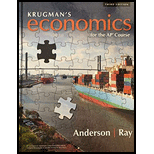
a.
The
a.
Explanation of Solution
The excess reserve refers to the reserve held by the bank above the
Therefore, excess reserve is $5,000.
Required reserve ratio: Required reserve ratio refers to the portion of the total money deposits that is collected by the banks. This amount cannot be used for further lending or investing purpose. The percentage is decided by the Federal Reserve.
b.
The amount should be held as reserve and the amount that can be lent out if additional deposit of $1,000 is made.
b.
Explanation of Solution
Given Information:
Required reserve ratio is 5%
Additional deposit is $1000
There is no excess reserve held with the bank.
Calculations:
The amount that bank can keep as reserve is as follows:
The amount after deducting reserves from the additional deposit can be lent out by the bank which is $950 ($1000-$50).
Required reserve ratio: Required reserve ratio refers to the portion of the total money deposits that is collected by the banks. This amount cannot be used for further lending or investing purpose. The percentage is decided by the Federal Reserve.
c.
The effect on money supply if reserves are increased by $2,000.
c.
Explanation of Solution
Money multiplier can be determined by using 1/reserve ratio which is computed as follows:
Change in money supply can be determined by multiplying the change in monetary base and the money multiplier. It is as follows:
Therefore, money supply will be change by $40,000
Required reserve ratio: Required reserve ratio refers to the portion of the total money deposits that is collected by the banks. This amount cannot be used for further lending or investing purpose. The percentage is decided by the Federal Reserve.
Chapter 25 Solutions
Krugman's Economics For The Ap® Course

 Principles of Economics (12th Edition)EconomicsISBN:9780134078779Author:Karl E. Case, Ray C. Fair, Sharon E. OsterPublisher:PEARSON
Principles of Economics (12th Edition)EconomicsISBN:9780134078779Author:Karl E. Case, Ray C. Fair, Sharon E. OsterPublisher:PEARSON Engineering Economy (17th Edition)EconomicsISBN:9780134870069Author:William G. Sullivan, Elin M. Wicks, C. Patrick KoellingPublisher:PEARSON
Engineering Economy (17th Edition)EconomicsISBN:9780134870069Author:William G. Sullivan, Elin M. Wicks, C. Patrick KoellingPublisher:PEARSON Principles of Economics (MindTap Course List)EconomicsISBN:9781305585126Author:N. Gregory MankiwPublisher:Cengage Learning
Principles of Economics (MindTap Course List)EconomicsISBN:9781305585126Author:N. Gregory MankiwPublisher:Cengage Learning Managerial Economics: A Problem Solving ApproachEconomicsISBN:9781337106665Author:Luke M. Froeb, Brian T. McCann, Michael R. Ward, Mike ShorPublisher:Cengage Learning
Managerial Economics: A Problem Solving ApproachEconomicsISBN:9781337106665Author:Luke M. Froeb, Brian T. McCann, Michael R. Ward, Mike ShorPublisher:Cengage Learning Managerial Economics & Business Strategy (Mcgraw-...EconomicsISBN:9781259290619Author:Michael Baye, Jeff PrincePublisher:McGraw-Hill Education
Managerial Economics & Business Strategy (Mcgraw-...EconomicsISBN:9781259290619Author:Michael Baye, Jeff PrincePublisher:McGraw-Hill Education





